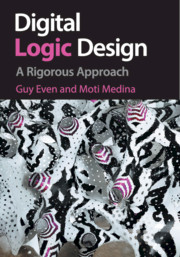
-
Select format
-
- Publisher:
- Cambridge University Press
- Publication date:
- 05 November 2012
- 08 October 2012
- ISBN:
- 9781139226455
- 9781107027534
- 9781108708036
- Dimensions:
- (253 x 177 mm)
- Weight & Pages:
- 0.79kg, 365 Pages
- Dimensions:
- (254 x 178 mm)
- Weight & Pages:
- 1kg, 368 Pages
You may already have access via personal or institutional login
Book description
This textbook, based on the authors' fifteen years of teaching, is a complete teaching tool for turning students into logic designers in one semester. Each chapter describes new concepts, giving extensive applications and examples. Assuming no prior knowledge of discrete mathematics, the authors introduce all background in propositional logic, asymptotics, graphs, hardware and electronics. Important features of the presentation are:All material is presented in full detail. Every designed circuit is formally specified and implemented, the correctness of the implementation is proved, and the cost and delay are analyzedAlgorithmic solutions are offered for logical simulation, computation of propagation delay and minimum clock periodConnections are drawn from the physical analog world to the digital abstractionThe language of graphs is used to describe formulas and circuitsHundreds of figures, examples and exercises enhance understanding.The extensive website (http://www.eng.tau.ac.il/~guy/Even-Medina/) includes teaching slides, links to Logisim and a DLX assembly simulator.
Reviews
'I highly recommend this book for academic courses on digital design.'
Vladimir Botchev Source: Computing Reviews
'… a very useful textbook … Throughout the book, the mathematical approach, the gradually presented notions and the very rigorous proofs are remarkable.'
Source: Zentralblatt MATH
Contents
Metrics
Full text views
Full text views help Loading metrics...
Loading metrics...
* Views captured on Cambridge Core between #date#. This data will be updated every 24 hours.
Usage data cannot currently be displayed.
Accessibility standard: Unknown
Why this information is here
This section outlines the accessibility features of this content - including support for screen readers, full keyboard navigation and high-contrast display options. This may not be relevant for you.
Accessibility Information
Accessibility compliance for the PDF of this book is currently unknown and may be updated in the future.


